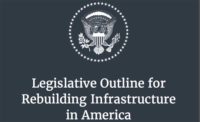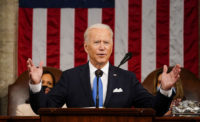Six days before his inauguration, President-elect Joe Biden has unveiled the framework of his first major legislative priority—a $1.9-trillion “American Rescue Plan” that seeks to address immediate problems stemming from the persistent coronavirus pandemic. The legislation would fund activities such as a stepped-up vaccination push, further payments to individuals, extended and increased unemployment benefits and expanded paid family leave, plus substantial aid to state and local governments and to schools.
The rescue plan, which Biden unveiled in a Jan. 14 speech in Wilmington, Del., has little or no infrastructure or construction-related funding.
But to construction industry officials, the major news may well have been Biden's statement that the rescue plan would be followed in February by a second key measure, a “Build Back Better recovery plan."
The president-elect said proposals would “make historic investments in infrastructure, along with manufacturing, research and development and clean energy.”
[View Biden Transition staff summary of rescue proposal here and prepared text of Biden's speech here.]
Biden said, “It’s time to stop talking about infrastructure and to finally start building an infrastructure so we can be more competitive.”
He added that it would produce “millions of good-paying jobs that put Americans to work rebuilding our roads, our bridges, our ports to make them more climate-resilient, to make them faster, cheaper, cleaner to transport American-made goods across our country and around the world.”
Biden did not say what the overall price tag for the recovery proposal would be.
Brian Turmail, a spokesman for the Associated General Contractors of America, said in emailed comments, "We do expect that second phase will include needed investments in aging and overburdened public infrastructure."
The rescue proposal, when fleshed out in the text of legislation, would have to win approval in Congress. After the inauguration on Jan. 20, the path for Biden's plan would be smoothed somewhat by Democrats' regaining control of the Senate, although just barely. Democratic wins in Jan. 5 runoffs in two U.S. Senate races in Georgia resulted in a 50-50 party split. But Vice-President-elect Kamala Harris would have the tie-breaking vote.
The House remained in Democrats' hands but with a margin of only 11 votes, as of Jan. 6.
Biden indicated the nation faces critical problems. "It's not hard to see that we're in the middle of a once-in-several-generations economic crisis with a once-in-several-generations public health crisis." he said. "A crisis of deep human suffering is in plain sight. And there's no time to waste. We have to act and we have to act now."
Up to Congress
Sen. Chuck Schumer (D-N.Y.), the incoming majority leader, and House Speaker Nancy Pelosi (D-Calif.) said in a joint statement, "We will get right to work to turn President-elect Biden's vision into legislation that will pass both houses of Congress."
Republican support in the House may be slim, at best, judging from a post-speech statement from Texas Rep. Kevin Brady, the top Republican on the tax-writing Ways and Means Committee. He blasted BIden's rescue plan as "yet another economic blind buffalo that does nothing to save Main Street businesses, get people back to work or strengthen our economy."
School Improvements
The only direct construction-related funding in the Biden rescue proposal can be found in the section dealing with aid to education. It would provide $130 billion for K-12 schools, for a variety of uses. One eligible use is physical improvements to school facilities, such as upgraded ventilation systems and modifications of indoor spaces to allow for social distancing.
But schools also could choose to use the funds to hire more janitors or school counselors, acquire more personal protective equipment or expand school bus service.
Colleges and universities would get $35 billion, but apparently that would go for additional financial aid of $1,700 per student.
AGC's Turmail said, "We do agree there is a need to invest in retrofitting schools so students can return to school, and teachers can remain safe, and we support the President-elect's call to include that funding in his initial relief measure."
Biden also wants Congress to authorize the Occupational Safety and Health Administration to issue a COVID-19 protection standard to cover workers, presumably including those in the construction industry. Organized labor has been seeking such an OSHA standard for months.
States, Localities, Transit
Other provisions in the plan could have some indirect benefits for construction, notably the $350 billion in assistance to state, local and territorial governments.
Biden said those funds would help keep key personnel on the job, including police officers, firefighters, other first responders and teachers. But shoring up state and local governments' operating budgets could allow officials avoid delaying infrastructure projects.
Transit systems would be a big winner, receiving $20 billion to avoid laying off workers but also making systems “more resilient,” according to a Biden transition team summary of the rescue proposal. That would supplement $14 billion that transit received in the coronavirus relief and omnibus spending package enacted on Dec. 27.
Also in the Biden plan, workers, including those in construction, would gain expanded emergency paid leave, receiving 14 weeks of paid sick, family and medical leave.
The federal government would reimburse employers that have fewer than 500 employees for the cost of this paid leave.
Hard-hit small businesses would receive $15 billion in "flexible, equitably distributed grants" to help them "get back on their feet," the transition team summary said.
Biden's plan also includes $35 billion in federal investment in state, local, tribal and nonprofit small-business financing programs that could spark as much as $175 billion in low-interest loans to assist entrepreneurs, according to the transition team fact sheet.






Post a comment to this article
Report Abusive Comment